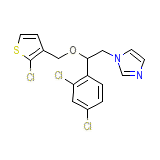N-Phthalimidoglutamic acid imide




N-Phthalimidoglutamic acid imide Brand names, N-Phthalimidoglutamic acid imide Analogs
- Algosediv
- Asidon 3
- Asmadion
- Asmaval
- Bonbrain
- Bonbrrin
- Calmore
- Calmorex
- Contergan
- Corronarobetin
- Distaval
- Distaxal
- Distoval
- Ectiluran
- Enterosediv
- Gastrinide
- Glupan
- Glutanon
- Grippex
- Hippuzon
- Imida-Lab
- Imidan
- Imidene
- Isomin
- Kedavon
- Kevadon
- Lulamin
- N-Phthalimidoglutamic acid imide
- N-Phthaloylglutamimide
- N-Phthalylglutamic acid imide
- Neaufatin
- Neo
- Neosedyn
- Neosydyn
- Nerosedyn
- Neufatin
- Neurodyn
- Neurosedin
- Neurosedym
- Neurosedyn
- Nevrodyn
- Nibrol
- Noctosediv
- Noxodyn
- Pangul
- Pantosediv
- Poly-Giron
- Polygripan
- Predni-Sediv
- Pro-ban M
- Profarmil
- Psycholiquid
- Psychotablets
- Quetimid
- Quietoplex
- Sandormin
- Sedalis
- Sedalis sedi-lab
- Sedimide
- Sedin
- Sedisperil
- Sedoval
- Shin-naito S
- Shinnibrol
- Sleepan
- Slipro
- Softenil
- Softenon
- THALOMID
- Talargan
- Talimol
- Talismol
- Telagan
- Telargan
- Telargean
- Tensival
- Thalidomide 99%
- Thalidomine USP26
- Thalin
- Thalinette
- Theophilcholine
- Ulcerfen
- Valgis
- Valgraine
- Yodomin
- alpha-phthalimidoglutarimide
N-Phthalimidoglutamic acid imide Brand Names Mixture
- No information avaliable
N-Phthalimidoglutamic acid imide Chemical_Formula
C16H13Cl3N2OS
N-Phthalimidoglutamic acid imide RX_link
http://www.rxlist.com/cgi/generic3/tioconaz.htm
N-Phthalimidoglutamic acid imide fda sheet
N-Phthalimidoglutamic acid imide msds (material safety sheet)
N-Phthalimidoglutamic acid imide Synthesis Reference
No information avaliable
N-Phthalimidoglutamic acid imide Molecular Weight
387.711 g/mol
N-Phthalimidoglutamic acid imide Melting Point
No information avaliable
N-Phthalimidoglutamic acid imide H2O Solubility
No information avaliable
N-Phthalimidoglutamic acid imide State
Solid
N-Phthalimidoglutamic acid imide LogP
4.971
N-Phthalimidoglutamic acid imide Dosage Forms
Cream; Ointment; Suppository (each applicator-full provides approximately 4.6 grams of ointment containing 300 mg of tioconazole)
N-Phthalimidoglutamic acid imide Indication
For the local treatment of vulvovaginal candidiasis (moniliasis).
N-Phthalimidoglutamic acid imide Pharmacology
Tioconazole is a broad-spectrum imidazole antifungal agent that inhibits the growth of human pathogenic yeasts. Tioconazole exhibits fungicidal activity in vitro against Candida albicans, other species of the genus Candida, and against Torulopsis glabrata. Tioconazole prevents the growth and function of some fungal organisms by interfering with the production of substances needed to preserve the cell membrane. This drug is effective only for infections caused by fungal organisms. It will not work for bacterial or viral infections.
N-Phthalimidoglutamic acid imide Absorption
Systemic absorption following a single intravaginal application of tioconazole in nonpregnant patients is negligible.
N-Phthalimidoglutamic acid imide side effects and Toxicity
Symptoms of overdose include erythema, stinging, blistering, peeling, edema, pruritus, urticaria, burning,
N-Phthalimidoglutamic acid imide Patient Information
N-Phthalimidoglutamic acid imide Organisms Affected
Yeast and other fungi














